Some of them will be familiar to you, others will be unknown, and yet they all had a key role in the emergence of the most famous artistic movement of the last two centuries: Welcome to the final article of our Impressionist saga (EP1, EP2).

1. Claude Monet, the legend
Claude Monet (1840 - 1926) is the superstar of Impressionism. Why? Certainly, because he was the most productive, the most extroverted (he knew everyone), the most inspiring and the most inspired. His multiform work is without a doubt the most representative of the movement. It corresponds to the standards of impressionism as we understand them today: break with academism, subjective apprehension of the subject, outdoor painting, use of bright colors, dilution of shapes and outlines...
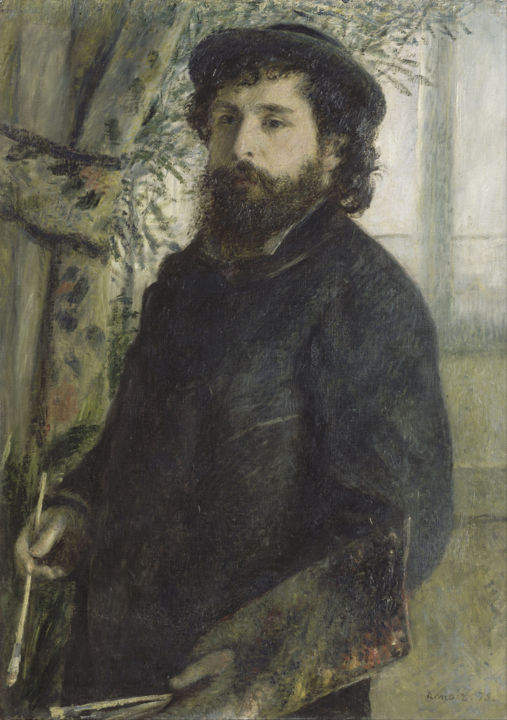
Auguste Renoir, Portrait of Claude Monet, 1875. Musée d'Orsay, Paris.
This artist from Normandy ticks all the boxes, and it's thanks to one of his most popular paintings, Impression, Sunrise, that Impressionism is called Impressionism. Shown at their first joint exhibition in 1874, this painting inspired a famous art critic to use the term "Impression" to bring together a group of artists (and friends) who practiced this new way of painting under the same banner.

Claude Monet, Impression, Sunrise, 1872-73. Musée Marmottan Monet, Paris.
- Financial situation: Poor during the beginning of his career, he was helped by his friends (Bazille, Manet, Caillebotte), some rare collectors (Charles Ephrussi, Victor Chocquet, Ernest Hoschedé...) and art dealers (Durand-Ruel, le Père Tanguy).
- Favorite themes: Landscapes, natural elements (especially waterlilies), monuments, outdoor scenes, portraits.
- Close relations: Auguste Renoir (with whom he painted regularly on the banks of the Seine), Frédéric Bazille (who helped him financially and lent him his studio), Camille Pissarro (with whom he took refuge in London to escape the ravages of the Franco-Prussian war), Alfred Sisley (at whose house he regularly dined), Eugène Boudin (his Norman mentor), Gustave Caillebotte, Paul Cézanne, Durand-Ruel (the dealer who trusted him), Edouard Manet (whose revolutionary spirit inspired him enormously), Berthe Morisot, Emile Zola...
- Places of pilgrimage: His (very) flowery house in Giverny, Normandy; the Musée d'Orsay, the Musée Marmottan-Monet and the Musée de l'Orangerie which hosts his most beautiful variations of water lilies (Paris).
- Quote: "The motif is something secondary, what I want to reproduce is what is between the motif and me."
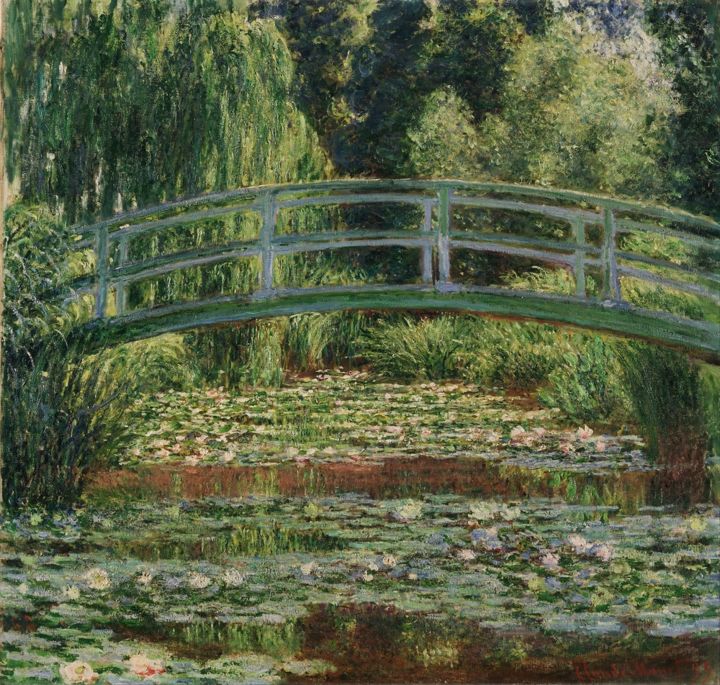
Claude Monet, Japanese Footbridge and Water Lily Pool, Giverny, 1899. Philadelphia Museum of Art.
2. Auguste Renoir, the intimate friend
Auguste Renoir (1841 - 1919) is, with Monet, Bazille and Sisley, one of the founding fathers of Impressionism. He met his fellow artists in the studio of the esteemed Charles Gleyre, which they left together, by consensus, to experiment with open-air painting on the banks of the Seine or in the forest of Fontainebleau. Under the influence of Monet, he learned to render the effects of light, a technique that would make him world famous, particularly thanks to the masterpiece Bal du Moulin de la Galette, painted in 1876 and purchased by his friend and patron, Gustave Caillebotte. In a career spanning 60 years, he produced more than 4,000 artworks (more than the works of Manet, Cézanne and Degas combined), always retaining his original and shimmering style.
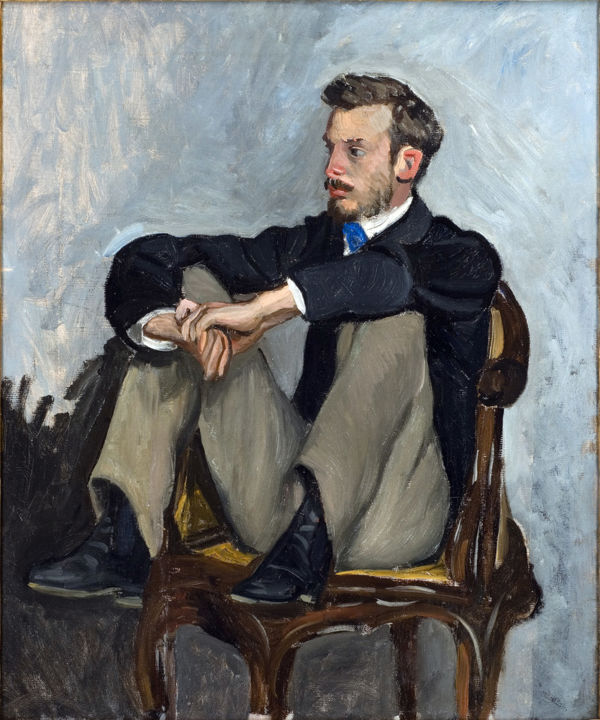
Frédéric Bazille, Portrait of Renoir, 1867. Musée d'Orsay, Paris.
- Financial situation: Coming from a relatively poor family, he lived in poverty at the beginning of his career. At only 13 years old, his talents as a draughtsman on porcelain allowed him to support himself.
- Favorite themes: Portraits, interior scenes, landscapes, nudes, seascapes, still lifes and genre paintings.
- Close relations: Claude Monet, Edouard Manet, Frédéric Bazille, Camille Pissarro, Alfred Sisley, Edgar Degas, Berthe Morisot, Gustave Caillebotte, Paul Cézanne, Durand-Ruel, Ambroise Vollard.
- Places of pilgrimage: Renoir Museum in Cagnes-sur-Mer, Musée d'Orsay (Paris), Renoir house/studio in Essoyes (France).
- Quote: "One morning, one of us ran out of black. He used blue: Impressionism was born."
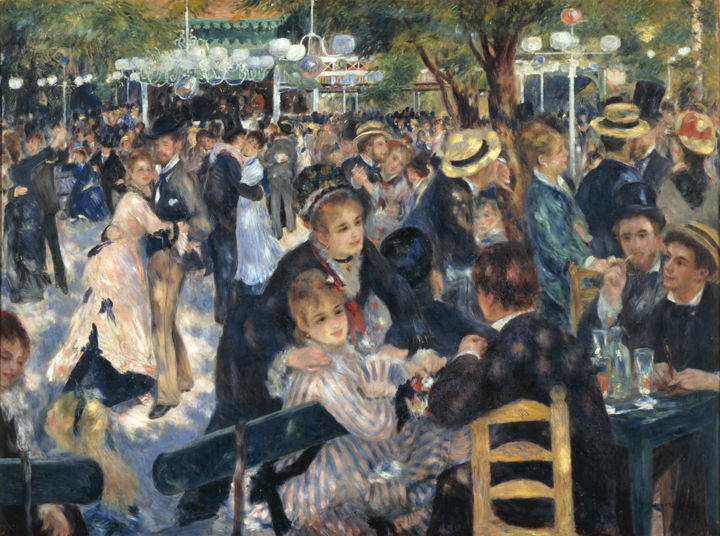
Auguste Renoir, Dance at Le Moulin de la Galette, 1876. Musée d'Orsay, Paris.
3. Edgar Degas, the friendly misanthrope
Edgar Degas (1834 - 1917) is the most controversial personality of Impressionism. Man of contradictions, it's said that he hated flowers, animals, women, children and also Jews. Austere, elitist, unsympathetic, misogynist... He was nevertheless appreciated by many of his contemporaries. Among his (very) many friends, we're surprised to find all the women of impressionism: Berthe Morisot, Mary Cassatt and Marie Bracquemond.
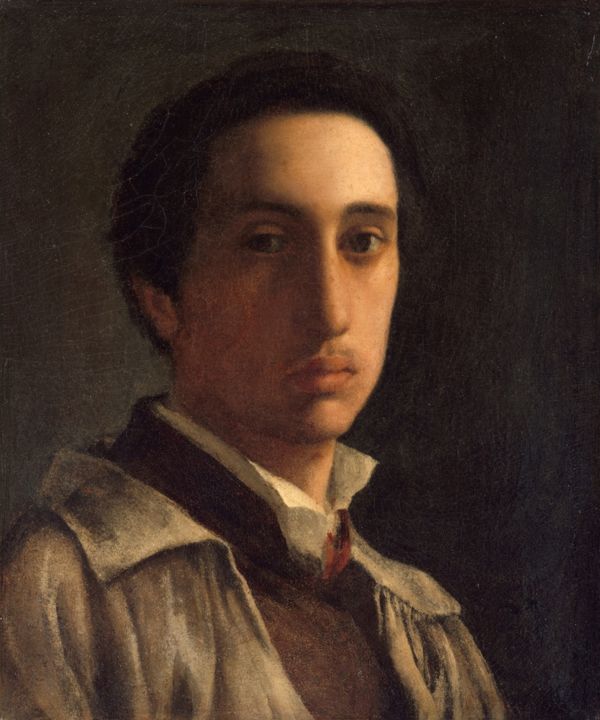
Edgar Degas, Self-portrait, circa 1855-1856. Metropolitan Museum of Art (New York).
His contradictory temperament was also expressed in his artistic practice: Although attached to impressionism (despite himself), Degas, like his friend Manet, showed a true classical will. Unlike Monet or Renoir, his ambition wasn't to revolutionize the art world, but to integrate it as best he could. He always favored drawing over color, and never succumbed to the temptations of open-air painting, which he vehemently abhorred. He was also a passionate and fascinating collector: from Delacroix to Ingres, passing by Manet, Gauguin, Cézanne, and some Van Gogh, he was obviously a tasteful man.
Very friendly with most of the Impressionists, he organized and participated in many collective exhibitions. When the Dreyfus Affair broke out, he revealed a decomplexed anti-Semitism: Edgar Degas wasn't a nice guy, and his former friends Monet, Sisley and Pissarro distanced themselves from this intransigent and intolerant character.

Edgar Degas, The Ballet Class, 1874. Musée d'Orsay, Paris.
- Financial situation: Supported by his family fortune, collector.
- Favorite themes: Interior scenes (ballerinas, bathers, orchestras), equestrian scenes, portraits.
- Close relations: Edouard Manet, Berthe Morisot, Mary Cassatt, Marie Bracquemond, Gustave Caillebotte, Durand-Ruel, Ambroise Vollard, Auguste Renoir, Paul Gauguin (cantankerous and toxic, just like him). After the Dreyfus Affair, Degas broke with his old friends Monet, Sisley and Pissarro.
- Place of pilgrimage: Musée d'Orsay, Paris.
- Quotes: "Impressionism means nothing. Every conscientious artist has always translated his impressions. "Your (academic) painting is a luxury object, ours is an object of first necessity".

Edgar Degas, The Absinthe Drinker, 1875-76. Musée d'Orsay, Paris.
4. Berthe Morisot, the independent
Berthe Morisot (1841 - 1895) is THE great lady of impressionism. She was part of all the exhibitions, all the events and all the relationships. Admired and respected by her peers, she wasn't the only woman of Impressionism, but she was undoubtedly the most important.

Edouard Manet, Berthe Morisot with a Bouquet of Violets, 1872. Musée d'Orsay, Paris.
Married to Edouard Manet's brother and very close to the artist, she followed him until his death in 1863, when she began to assert her independence and her unique and original style. Throughout her career, she only painted interior scenes, because at the time, women weren't allowed to go out unaccompanied. It was therefore unthinkable for them to stroll for hours in front of an easel (and that's regrettable!).
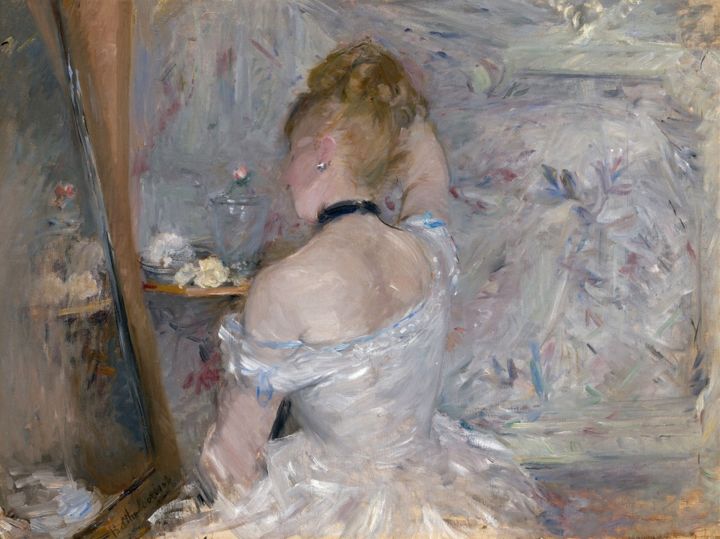 Berthe Morisot, Lady at her Toilette, 1875. Art Institute of Chicago.
Berthe Morisot, Lady at her Toilette, 1875. Art Institute of Chicago.
- Financial situation: Coming from a bourgeois family, her marriage to Eugène Manet ensured her a peaceful existence until the end of her life.
- Favorite themes: Interior scenes (almost compulsory for a woman at the time), maternity scenes, scenes of female intimacy, nudes, portraits.
- Close relations: Edouard Manet (her brother-in-law), Edgar Degas, Claude Monet, Auguste Renoir, Camille Pissarro, Alfred Sisley, Gustave Caillebotte, Mary Cassatt, Durand-Ruel.
- Places of pilgrimage: Musée d'Orsay and Musée Marmottan-Monet (Paris), National Gallery of Art (Washington), Art Institute of Chicago.
- Quote: "I don't think there has ever been a man who treated a woman as an equal, and that's all I would have asked for – I know I am worth as much as they are."
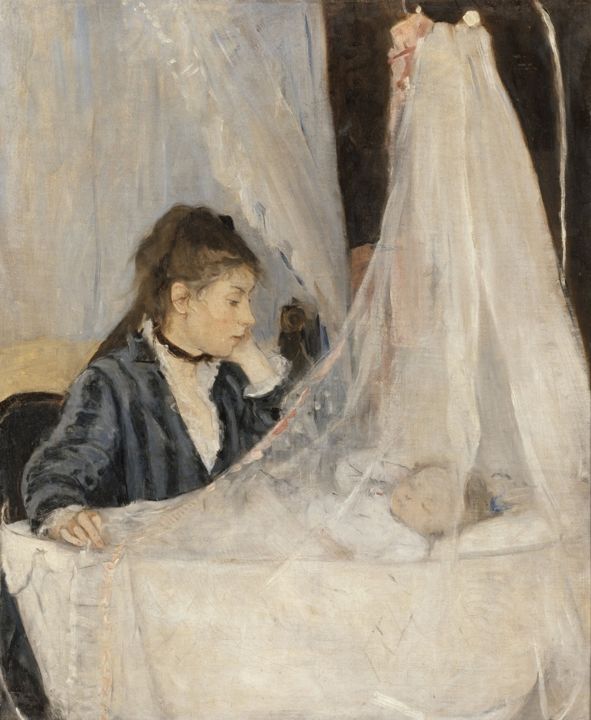
Berthe Morisot, The Cradle, 1872. Musée d'Orsay, Paris.
5. Camille Pissarro, the elder
Within the Impressionist group, Camille Pissarro (1830 - 1903) was the oldest. Friend of all, he was also the teacher of two famous Paul: Gauguin and Cézanne. Very involved in the Impressionist epic, he was the only one to have participated in all their exhibitions (eight in total). His advanced age didn't make him the most conservative, quite the contrary. Camille Pissarro was a man of experience in every sense of the word. He had a solid artistic knowledge, but he was also enthusiastic about new experiences. When the first pointillist works appeared (Georges Seurat, Paul Signac), which made most impressionists' blood run cold, Pissarro was completely fascinated, so much so that he tried it himself.
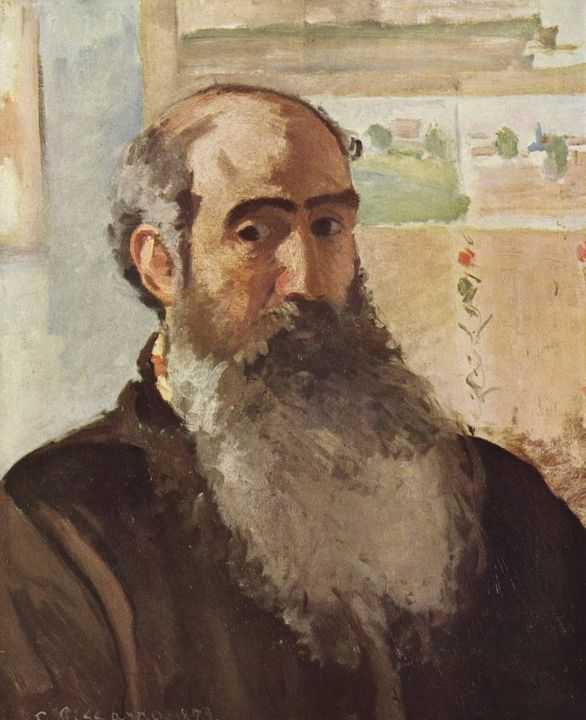
Camille Pissarro, Self-portrait, 1873. Musée d'Orsay, Paris.
A sincere friend, always willing to give good advice, Pissarro was aware that his work would never make as much of an impression as that of his companions Monet, Renoir or Degas. A few years before his death, he would even express "I remain, with Sisley, as a tail of Impressionism." (1895). Anarchist in the soul, his friendships with Renoir and Degas (openly anti-Semitic) were broken when the Dreyfus Affair occurred in 1894.
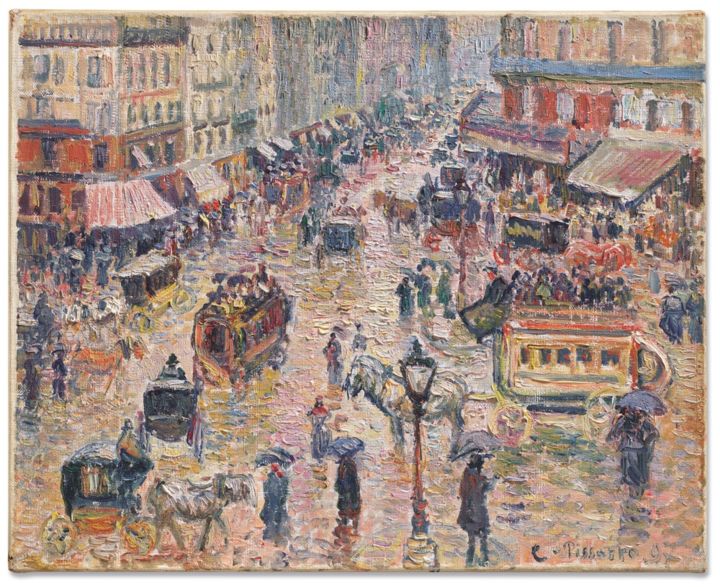
Camille Pissarro, Place du Havre, Rain, 1897. Private collection.
- Financial situation: Abandoned by his family following his marriage to a maid, he was in great difficulty almost until the end of his life and was regularly helped and sheltered by his friends (notably Caillebotte and Monet).
- Favorite themes: Landscapes, Parisian monuments, still lifes.
- Close relations: Claude Monet, Auguste Renoir (before the Dreyfus affair), Frédéric Bazille, Alfred Sisley, Berthe Morisot, Edgar Degas (before the Dreyfus affair), Paul Cézanne, Paul Gauguin, Gustave Caillebotte, Mary Cassatt, Durand-Ruel.
- Places of pilgrimage: Camille Pissarro Museum in Pontoise (Paris region), Musée d'Orsay (Paris), Metropolitan Museum of Art (New York).
- Quote: "As a matter of principle, we didn't want a school, we like Delacroix, Courbet, Daumier and all those who have something in their belly, and nature, the open air, the different impressions that we feel, all our concern. All false theories, we repudiate them.”

Camille Pissarro, La Récolte des Foins à Eragny, 1887. Van Gogh Museum (Amsterdam).
6. Alfred Sisley, the underrated
Although he was one of the founders of Impressionism, Alfred Sisley (1839 - 1899) remains one of its least known personalities, compared to the international celebrities such as Monet, Renoir, Degas, or Manet. He was never famous during his lifetime. In painting, he only found ecstasy through landscapes, creating masterpieces of this genre with each brush stroke. His lifestyle alternated between Parisian socializing at the Café Guerbois with his friends, and relaxing stays in the country where he could devote himself to open-air painting.
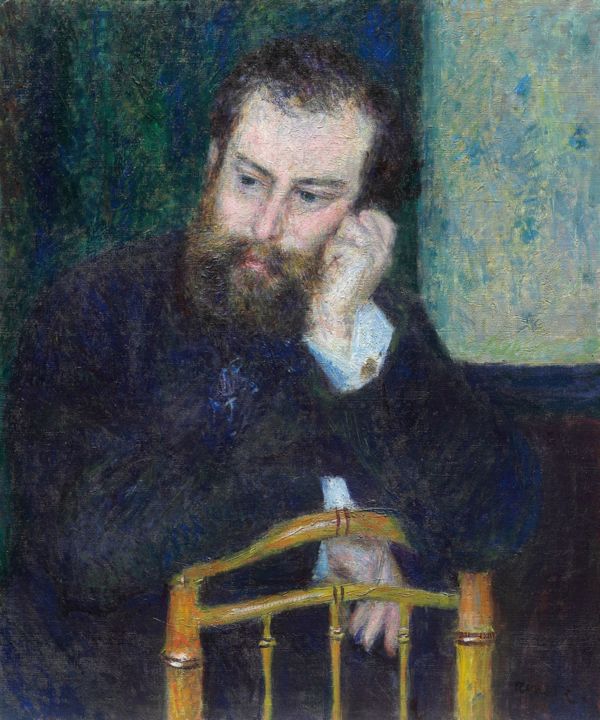
Auguste Renoir, Portrait of Alfred Sisley, 1874. Art Institute of Chicago.
- Financial situation: Sustained by his family fortune until the age of 27, he was then disinherited and had to support his family with great difficulty.
- Favorite themes: Landscapes, monuments and some still lifes.
- Close relations: Claude Monet, Auguste Renoir, Frédéric Bazille, Camille Pissarro, Marie Bracquemond, Berthe Morisot, Gustave Caillebotte, Durand-Ruel (who bought him about 400 paintings).
- Places of pilgrimage : Dispersed artwork - Musée d'Orsay (32 paintings), Musée des Beaux-Arts de Rouen (8 paintings), Philadelphia Museum of Art (7 paintings), Ordrupgaard Museum in Copenhagen (6 paintings), Musée du Petit Palais de Paris (4), Musée du Louvre (3), MuMa Le Havre (3), Palais des Beaux-Arts de Lille (3), Musée des Beaux-Arts de Montréal (3), NY Carlsberg Glyptotek Copenhagen (3), Staatsgalerie Stuttgart (3)... Some of his artworks are also present in Russia, Switzerland, Belgium, Italy, the United Kingdom, the Czech Republic and Algeria.
- Quote: "Every painting shows something that the painter has fallen in love with."
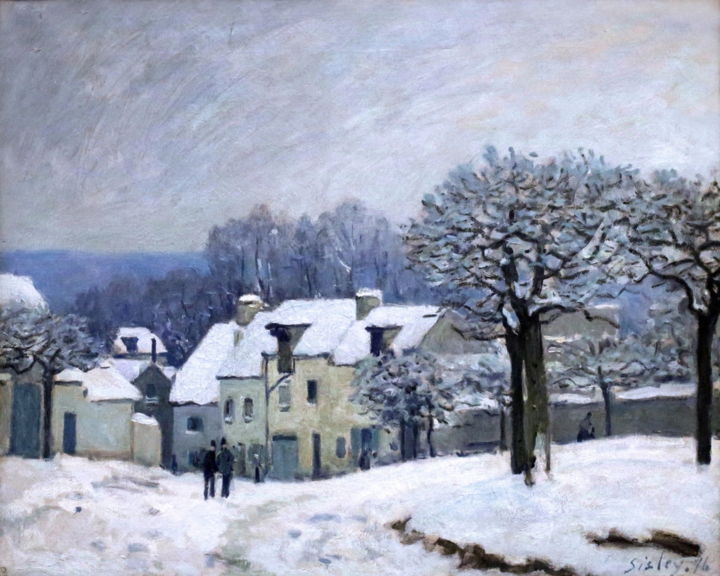
Alfred Sisley, Place du Chenil in Marly, Snow Effect, 1876. Musée des Beaux-Arts de Rouen (France).
7. Frédéric Bazille, the cursed
Frédéric Bazille (1841 - 1870) was present at the genesis of Impressionism, when they decided, with Monet, Renoir, and Sisley, to leave the studio of Charles Gleyre, an early academician obsessed with ancient art. Born into the Montpellier bourgeoisie and destined to a brilliant future as a doctor like his ancestors, he turned away from this vocation to pursue his true passion: painting.
Thanks to the financial support of his family, he settled in Paris and produced numerous paintings mixing finesse and lightness. Inspired by the casualness of Edouard Manet, his favorite themes turned out to be deeply singular: river bathing scenes, sunny family portraits...
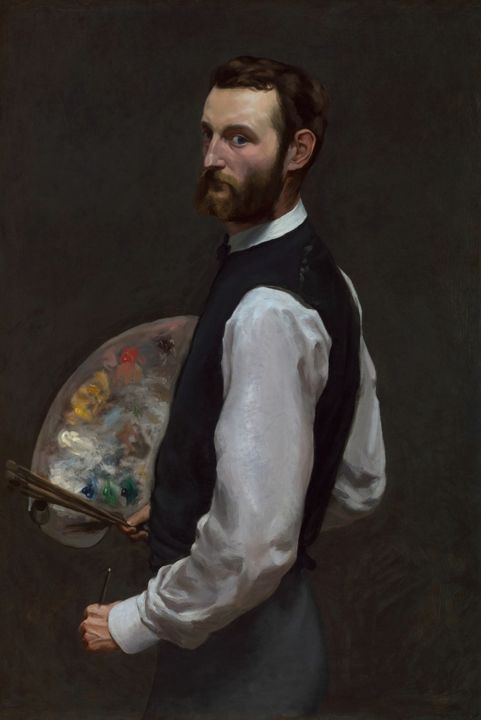
Frédéric Bazille, Self-Portrait, 1865-66. Art Institute of Chicago.
Far from Parisian society, his paintings are marked by ethnic diversity, sensitivity, and homoeroticism. He was unfortunately cut down in his young creative years, dying on the warfront in 1870. This premature death plunged his artwork into oblivion, despite an undeniable originality that would have made him one of the most famous impressionists of our era.

Frédéric Bazille, Young Woman with Peonies, 1870. National Gallery of Art (Washington).
- Financial situation: Supported by the family fortune, collector, and patron.
- Favorite themes: Summer scenes, interior scenes, family scenes, landscapes, portraits, flowers, still lifes.
- Close relations: Claude Monet, Auguste Renoir, Alfred Sisley, Edgar Degas, Camille Pissarro, Berthe Morisot, Edouard Manet, Henri Fantin-Latour, Paul Cézanne, Emile Zola, Paul Verlaine.
- Places of pilgrimage: Musée d'Orsay (Paris) and Musée Fabre (Montpellier) which hosts most of his artworks.
- Quote: "For me, I am sure not to be killed: I have too many things to do in my life" (one day before his death)
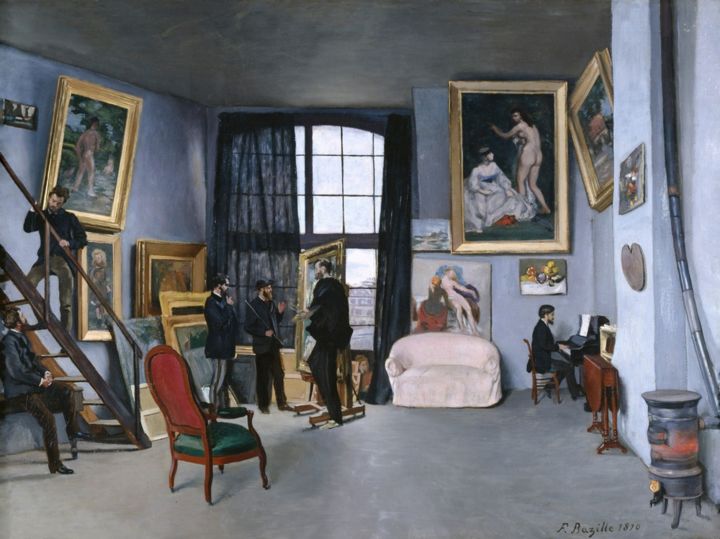
Frédéric Bazille, Bazille's studio, 1870. In this painting, we can see his friends Manet, Monet, and Renoir.
8. Mary Cassatt, the American expatriate
Mary Cassatt (1844 - 1926) is the international element of the group. Born into an American family of French origins, she always maintained close ties with the Parisian artistic microcosm. Very close to Edgar Degas, he introduced her to the Impressionist group, thanks to which she could freely express her singular style, and participate in joint exhibitions to showcase her work.
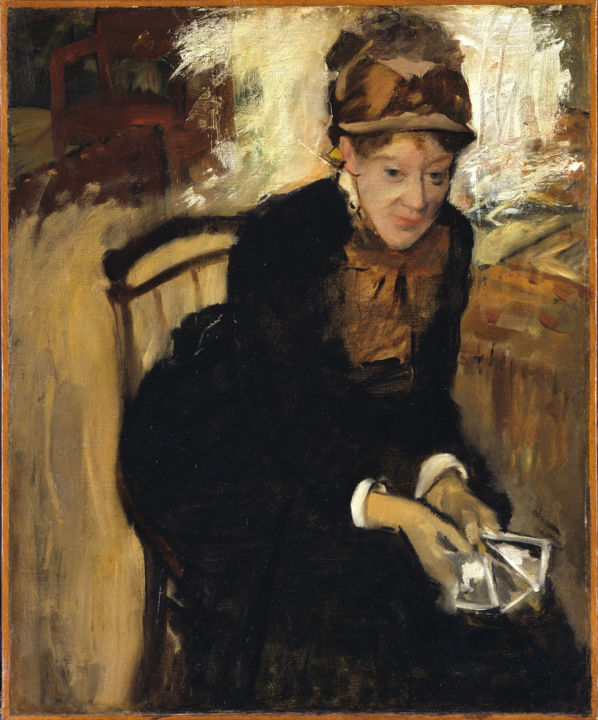
Edgar Degas, Portrait of Mary Cassatt, circa 1880-1884. National Portrait Gallery (Washington).
Independent, single and without descendants, Mary Cassatt nevertheless produced most of her artwork on the theme of motherhood and childhood, as if to exorcise a model imposed by society that she didn't appreciate. Far from being a simple follower, her style was perfectly in line with the Impressionist approach (vibrant palette, play of light, Japanese motifs), and she played a key role in the export of the movement, especially to the United States. She helped the dealer Paul Durand-Ruel to set up his gallery across the Atlantic and used her network of American friends and collectors to promote the modern cause.

Mary Cassatt, Little Girl in a Blue Armchair, 1878. National Gallery of Art (Washington).
- Financial situation: Supported by the family fortune.
- Favorite themes: Interior scenes (obviously, it was a woman at the end of the 19th century), maternity scenes, portraits.
- Close relations: Edgar Degas, Berthe Morisot, Camille Pissarro, Durand-Ruel, Ambroise Vollard.
- Places of pilgrimage: Dispersed artwork: National Gallery of Art (Washington), Philadelphia Museum of Art, Art Institute of Chicago, Musée d'Orsay (Paris).
- Quote: "There are only two ways for a painter: one wide and easy, the other narrow and difficult."
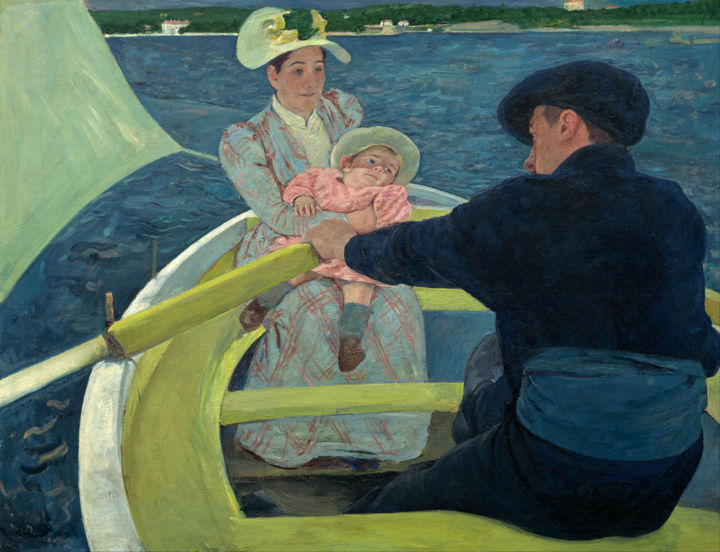
Mary Cassatt, The Boating Party, 1893. National Gallery of Art (Washington).
9. Gustave Caillebotte, the patron
Gustave Caillebotte (1848 - 1894), was the friend and the unexpected support of the Impressionist group after their first failures. He joined the movement late and was the youngest of the group: he was only 22 years old in 1870 when Bazille died (at 28). He met the Impressionists (notably Monet and Degas) during the years 1872-73. At that time, he was already a painter and dreamed of academic acceptance. His hopes were quickly shattered by a series of rejections at the Official Salon, which led him to join the Impressionist movement with strength and vigor.
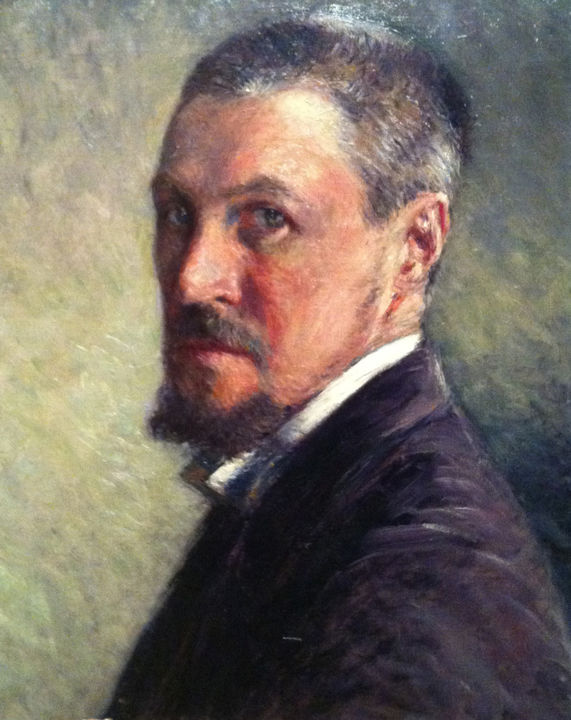
Gustave Caillebotte, Self-portrait, circa 1889. Musée National des Beaux-Arts du Québec.
When his father died in 1874, he inherited an immense fortune which he spent on helping his friends, organizing Impressionist exhibitions, and buying symbolic artworks of the movement, making him one of the greatest collectors and patrons of Impressionism at the end of the century. Both protector and companion, he maintained his friendships with the group until the end of his life.
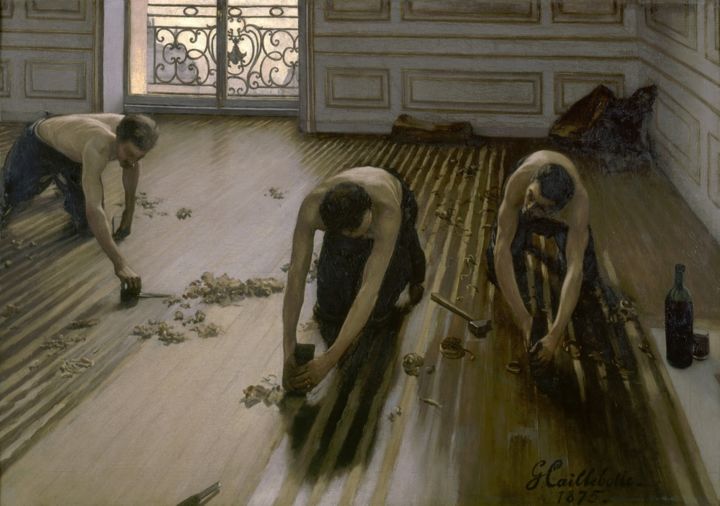
Gustave Caillebotte, The Floor Scrapers, 1875. Musée d'Orsay, Paris.
- Financial situation: Supported by the family fortune, collector, and patron.
- Favorite themes: Parisian Street scenes, scenes of worldly life, scenes of labour, nautical scenes, landscapes, seascapes.
- Close relations: Claude Monet (to whom he rented an apartment in Paris), Camille Pissarro (whom he helped regularly), Auguste Renoir (who became his testamentary executor), Alfred Sisley, Paul Cézanne, Edgar Degas, Edouard Manet, Berthe Morisot, Durand-Ruel.
- Places of pilgrimage: Le Casin, his former house in Yerres (Paris region), Musée d'Orsay (Paris).
- Quote: "Nobody wants it? I’ll buy it".

Gustave Caillebotte, Paris Street; Rainy Day, 1877. Art Institute of Chicago.
10. Edouard Manet, the avant-gardist
Edouard Manet (1832 - 1883) experienced all the scandals. Shy but ambitious, he didn't seek controversy. Despite himself, each appearance of his paintings, which have become legendary (Olympia, Le Déjeuner sur l'herbe, the Fifer...), ruffled the feathers of public opinion and critics.

Edouard Manet, Self-Portrait with Palette, 1879. Private collection.
Invested by the sacred fire of modernity, he's considered by some as the unofficial leader of impressionism, a movement to which he didn't want to be affiliated. Manet always maintained a distance from the Impressionists, while keeping a very good relationship with them, between inspiration and protection. Manet shared with Degas a deep interest in academic validation: he wished to modify academism, not to confront it like most Impressionists. This explains why his subjects were so different from most of the other members of the group, and it also explains why he didn't participate in any joint exhibitions, although he appreciated his fellow artists of artistic revolution.

Edouard Manet, The Luncheon on the Grass, 1863. Musée d'Orsay, Paris.
- Financial situation: Supported by his family fortune, collector and patron.
- Favorite themes: Genre painting, genre portraiture, outdoor scenes, still life.
- Close relations: Edgar Degas, Claude Monet, Auguste Renoir, Frédéric Bazille, Berthe Morisot (his sister-in-law), Eva Gonzales (his disciple), Marie Bracquemond, Gustave Caillebotte, Henri Fantin-Latour, Emile Zola, Charles Baudelaire.
- Places of pilgrimage: Musée d'Orsay (Paris), National Gallery of Art (Washington), Art Institute of Chicago, Metropolitan Museum of Art (New York).
- Quote: "Who said that drawing is the writing of form? The truth is that art must be the writing of life.”

Edouard Manet, Olympia, 1863. Musée d'Orsay, Paris.
11. Marie Bracquemond, the discreet
Although little known to the general public, Marie Bracquemond (1840 - 1916) was a great lady of the impressionist movement. A student of Ingres (impressive!), she finally turned to Impressionism thanks to her friendships with Manet and the Sisley couple. She participated twice in the group's exhibitions. A fiery innovator, she didn't limit herself to painting on canvas: over the years, she produced numerous watercolors, etchings and painted ceramics.

Marie Bracquemond, Self-portrait, 1870. Unknown location.
In the 1890s, she had to end her career as an artist. Her husband was publicly bothered by her creative freedom, judgments were made, and Marie Bracquemond decided to become the discreet and docile woman that her husband and society demanded. A very sad story, symbol of an archaic era. She died in 1916, without public opinion recognizing her importance.
- Favorite themes: Interior scenes (obviously), portraits, landscapes and still life.
- Close relations: Edouard Manet, Alfred Sisley, Edgar Degas.
- Places of pilgrimage: Dispersed artwork - Musée d'Orsay, Petit Palais (Paris), Musée des Beaux-Arts de Rouen, Musée de Cambrai, Musée Fabre (Montpellier), Musée de Genève.

Marie Bracquemond, Under the Lamp, 1887. Galleries Maurice Sternberg, Chicago.
12. Eva Gonzales, the disciple
Eva Gonzales (1847 - 1883) is certainly the least known Impressionist on this list. Her premature death and her refusal to participate in the various impressionist exhibitions are certainly the main reason for this. Of Spanish origin, she became a student of Edouard Manet and developed a friendly relationship with her master, provoking the jealousy of her contemporary Berthe Morisot. Her closeness to Manet would be felt throughout her short career, whether in her attitude towards the Impressionist group or in the singular treatment of her subjects. She died in 1883, at the age of 36. This unexpected death unfortunately didn't allow her to express the full depth of her talent.
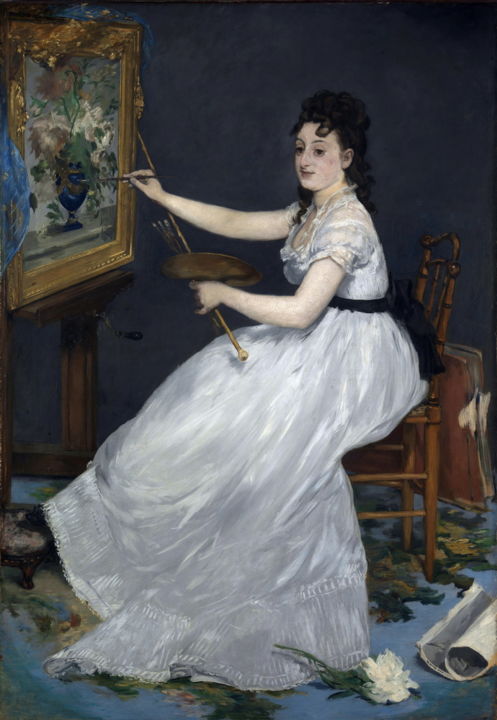
Édouard Manet, Portrait of Eva Gonzalès, 1869-1870. Londres, National Gallery.
- Financial situation: Supported by the family fortune.
- Favorite theme: Portrait, interior scene, landscape.
- Close relations: Edouard Manet, Emile Zola, Paul Cézanne.
- Place of pilgrimage: Dispersed artwork - Soumaya Museum (Mexico), National Gallery of Art (Washington), Art Institute of Chicago, Kunsthalle of Bremen (Germany), Belvedere Palace of Vienna (Austria), Ordrupgaard Museum (Copenhagen, Denmark), Dieppe Museum, Gajac Museum, Musée des Beaux-Arts de Marseille, Musée d'Orsay.

Eva Gonzales, The Milliner, 1882-1883. Art Institute of Chicago.
13. Paul Cézanne, the provincial
Paul Cézanne (1839 - 1906) remained divided between the capital and his native village, Aix-en-Provence, throughout all his life. Paris allowed him to present his artworks and to claim success, the same success that his childhood friend, the illustrious writer Emile Zola, was soon to experience. On the other hand, his Provencal village brought him rest and comfort, but above all the inspiration necessary for a painter who flourished through green landscapes.

Auguste Renoir, Portrait of Paul Cézanne, 1880. Private collection.
In Paris, he met the Impressionist group, befriended them, and discovered that they shared a common desire, although their styles remained, in essence, quite different. He participated in only two Impressionist exhibitions. A gruff and temperamental man, he then moved away from the group to spend his days painting the most beautiful mountain panoramas of the south of France.

Paul Cézanne, The House of Hanged Man, circa 1874. Musée d'Orsay, Paris.
- Financial situation: Coming from a bourgeois family that didn't appreciate his choice of career, it didn't help him. He lived painfully until his artistic and financial success in his last years.
- Favorite themes: Landscape, portrait, genre paintings.
- Close relations: Emile Zola (his childhood friend), Camille Pissarro (his master and favorite impressionist), Claude Monet, Auguste Renoir, Gustave Caillebotte, Eva Gonzales, Ambroise Vollard.
- Places of pilgrimage: Cézanne's studio and Musée Granet in Aix-en-Provence (South of France), Musée d'Orsay and Musée de l'Orangerie (Paris), Hermitage Museum (Saint Petersburg), Pushkin Museum (Moscow).
- Quote: "Nature must be treated by the cylinder, the sphere and the cone."
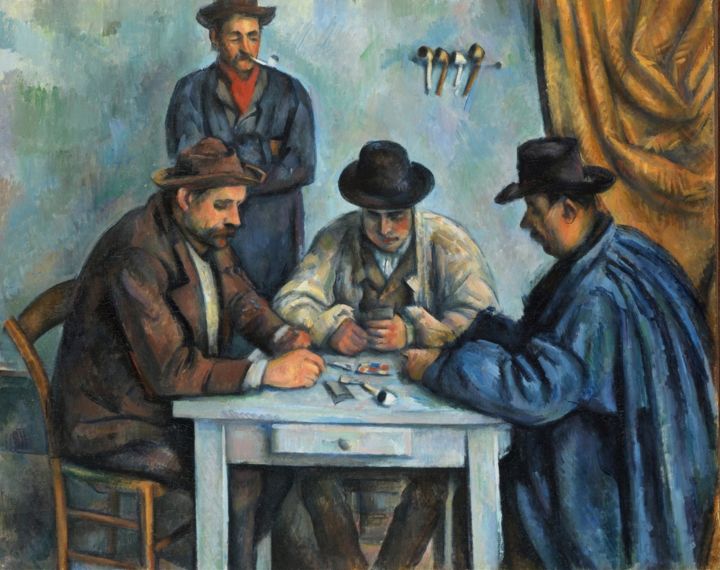
Paul Cézanne, The Card Players, 1890-92. Metropolitan Museum of Art (New York).
And that's it, this ranking is finished. However, to be completely exhaustive, we should add to these painters, other actors without whom impressionism would never have reached the heights it has today. Without the merchants who gave their confidence (Durand Ruel, Ambroise Vollard, Père Tanguy), without the collectors who gave their support (Victor Chocquet, Théodore Duret, Charles Ephrussi, Ernest Hoschedé... ), without the art critics who participated in their promotion (Emile Zola, Charles Baudelaire, Edmond Duranty) and without their faithful friends, patrons, and painters of inferior renown (Armand Guillaumin, Henri Rouart, Henri Fantin-Latour, Eugène Boudin, Gauguin, Nadar...) the impressionist artists would certainly have kept their place as decadent painters on the bangs of official art, condemned to contempt, to quick oblivion and to the silence of eternity.


Impressionism is a common artwork, the result of the enthusiasm of an era and the creative ardor of a handful of painters ready to upset the established patterns. It is the sum of encounters, sincere friendships and confrontations with conventional art. This is why this free and innovative movement still vibrates in our hearts!


 Bastien Alleaume (Crapsule Project)
Bastien Alleaume (Crapsule Project)